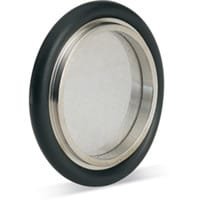KF (QF) HV Centering Rings with Screen (SS)
In ultra-high vacuum (UHV) systems, achieving a leak-tight seal and precise alignment is crucial for maintaining system integrity and preventing contamination. KF (QF) HV Centering Rings with Screen (SS), designed and manufactured by TFM, are key components that ensure optimal performance in high-vacuum environments. These rings are specifically crafted to deliver a durable, reliable solution for sealing and aligning flanges in UHV applications.
What are KF (QF) HV Centering Rings with Screen (SS)?
The KF (QF) HV Centering Rings with Screen (SS) are designed to enhance vacuum integrity by providing both precise alignment and secure sealing between KF (QF) vacuum flanges. Constructed with a stainless steel screen, these centering rings offer increased strength and resistance to wear and tear, making them ideal for high-vacuum systems that require durability and long-term reliability.
These rings not only help in aligning and sealing the flanges but also play a critical role in preventing contamination by ensuring that no particles enter the vacuum system. The inclusion of a stainless steel screen offers added protection against damage from external elements, further enhancing the longevity and performance of the system.
Key Features of KF (QF) HV Centering Rings with Screen (SS)
Stainless Steel Screen: The stainless steel screen is designed to offer exceptional strength, corrosion resistance, and durability, ensuring a long service life even in harsh environments. It prevents particles from entering the system, contributing to the cleanliness and integrity of the vacuum.
Leak-Tight Sealing: The precise sealing function ensures that the vacuum integrity is maintained, preventing any loss of vacuum pressure and safeguarding the system against leaks.
Precise Alignment: These centering rings provide the necessary alignment between flanges, ensuring that the connection remains stable and consistent, even under varying pressures and temperatures.
Wide Compatibility: The rings are compatible with a variety of KF (QF) vacuum flanges, including KF10, KF16, KF25, KF40, and KF50. This broad compatibility allows for flexibility in a variety of vacuum systems.
Benefits of Using KF (QF) HV Centering Rings with Screen (SS)
Durability: Made with high-quality stainless steel, these centering rings are built to withstand the harsh conditions of high-vacuum environments, ensuring a long-lasting solution for your vacuum systems.
Leak Prevention: The stainless steel screen and O-ring combination work together to provide a reliable, leak-tight seal, which is critical for maintaining the vacuum integrity of the system.
Prevents Contamination: By securely sealing the flanges, these centering rings prevent contamination from entering the system, making them ideal for sensitive applications such as semiconductor processing and analytical instrumentation.
Easy Integration: Designed for compatibility with a wide range of KF (QF) flanges, these centering rings can be easily integrated into existing systems without requiring major modifications.
Applications of KF (QF) HV Centering Rings with Screen (SS)
The KF (QF) HV Centering Rings with Screen (SS) are essential components in a wide variety of applications, including:
Semiconductor Processing: These centering rings help maintain vacuum integrity in semiconductor equipment, where high precision and cleanliness are paramount.
Pumping Systems: The rings are crucial for sealing and aligning flanges in vacuum pumps, ensuring that the system maintains a consistent vacuum.
Vacuum Chambers: Whether for research or industrial purposes, these centering rings are used in vacuum chambers to create leak-tight connections between chamber components.
Analytical Instruments: These rings play a significant role in maintaining the performance of high-precision instruments used in laboratories and research settings.
Ordering Table
| Drawing | Flange OD | Dim A | Dim B | Part Number |
|
| KF16 | 0.5 | 0.67 | QF16-SRV-SM |
|
| KF25 | 0.86 | 1.03 | QF25-SRV-SM |
|
| KF40 | 1.45 | 1.61 | QF40-SRV-SM |
|
| KF50 | 1.88 | 2.05 | QF50-SRV-SM |
Accessories Table
| Description | Part Number |
| Vacuum and Lubricating Grease | APMB |
| Replacement o-ring | O-V314 |
| Replacement o-ring | O-V320 |
| Replacement o-ring | O-V326 |
| Replacement o-ring | O-V330 |





Reviews
There are no reviews yet.